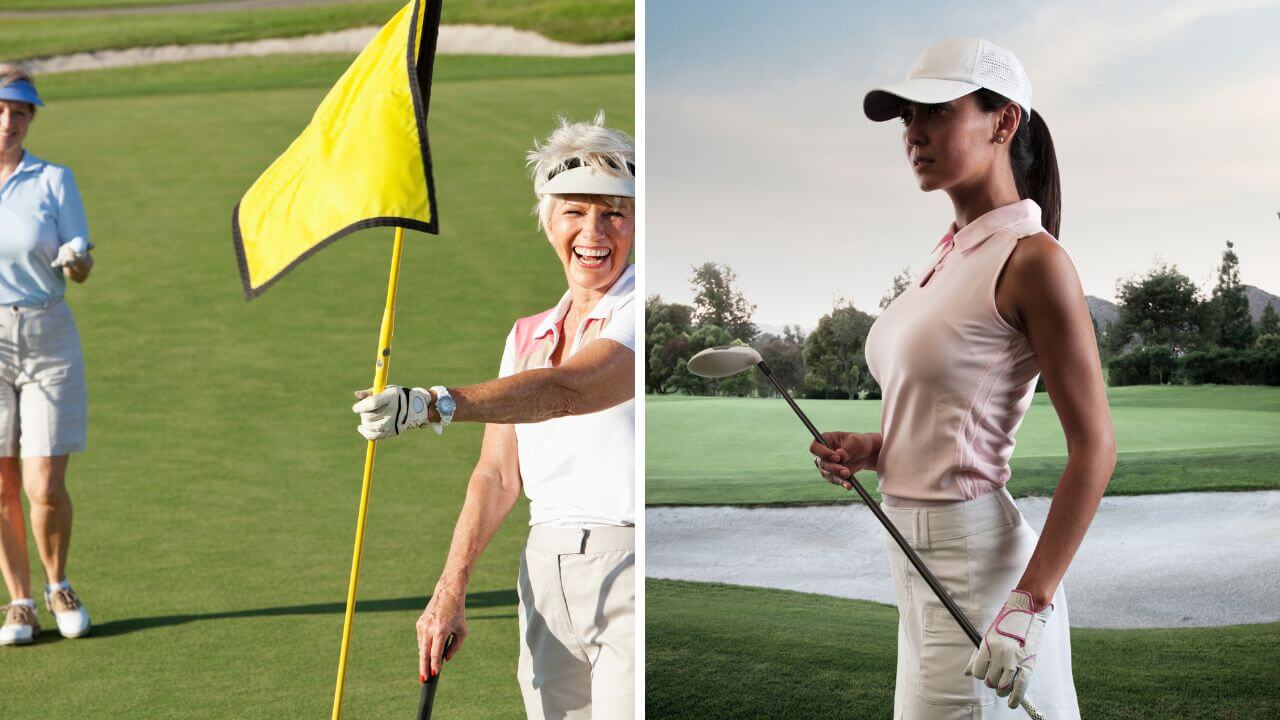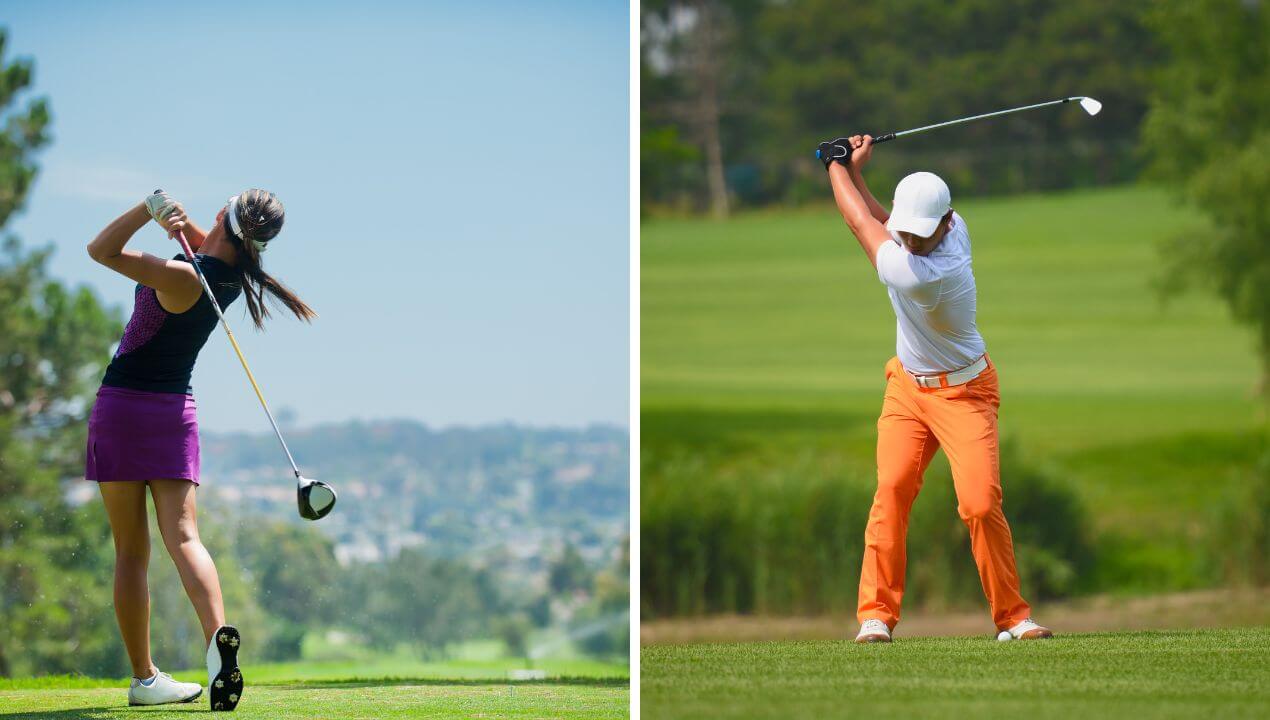Content Summary
The word "grip" in golf has many meanings. There's the actual material grip on the club itself, then there's the style of grip you use: overlap, interlocking or ten finger.
After that you have the position grip on the club: neutral, weak and strong. We will primarily be discussing the position grip today but as with all things golf, some discussion of the others will occur.
If you're anything like me then you've probably had those times where you just can't seem to hit the ball straight. You're either slicing or hooking the ball and you start to question your setup and everything else.
The first place I would suggest you look is your position grip. It's one of the more critical elements in achieving accuracy. It is said that a proper grip can make or break your golf swing, and this assertion holds true when it comes to accuracy.
A correct grip allows you to have greater control over your clubface and results in a better ball flight path. An incorrect grip can lead to slices, hooks and other inaccuracies that can add strokes to your scorecard.
Hence, understanding what makes for the best golf grip for accuracy is paramount for any golfer looking to improve their game. Common issues faced by golfers as a result of an incorrect grip include inconsistency with ball-striking, reduced distance, and limited shot-making options.
Fortunately, there are several types of golf grips that can be used by you, the player, to help fine-tune your shots. The three primary types of grips are neutral, weak and strong grips.
A neutral grip involves placing both hands on the club with no emphasis on either side while a weak/strong grip entails positioning one hand further towards either side of the clubhead than the other hand. Each type has its benefits and drawbacks that need careful consideration before choosing which one is best suited for you.
The Best Golf Grip for Accuracy
It is said that a proper grip can make or break your golf swing, and this assertion holds true when it comes to accuracy. A correct grip allows you to have greater control over your clubface and results in a better ball flight path.
A neutral golf grip (my preferred choice) is considered to be the best for accuracy and can help ensure that your clubface is square at impact, which can lead to straighter shots and a more consistent ball flight path.
An incorrect grip can lead to slices, hooks and other inaccuracies that can add strokes to your scorecard. Hence, understanding what makes for the best golf grip for accuracy is paramount for any golfer looking to improve their game.
An incorrect grip can create inconsistency with ball-striking, reduced distance, and limited shot-making options. Fortunately, there are several types of golf grips that can be used by players to help fine-tune their shots.
The three primary types of grips are neutral, weak and strong grips. A neutral grip involves placing both hands on the club with no emphasis on either side while a weak/strong grip entails positioning one hand further towards either side of the clubhead than the other hand.
Your left hand grip on the golf club should be snug but not too tight, with the thumb running down the shaft and the "V" formed by your thumb and forefinger pointing towards your right shoulder.
The right hand should be positioned below the left hand using a interlock, overlap or ten finger grip and the "V" of that hand pointing to your right shoulder as well.
A strong grip tends to close the face of the club at impact, which can cause hook shots or pulls, while a weak grip opens up the face and leads to slices or fades.
I play with a friend who has a strong grip, aligns himself up right of target yet can hit the ball straight. But he is doing this with his body rotation so when his timing is off his shots generally go way right (very unique situation).
There are various types of material grips available, including rubber grips that offer good traction in wet conditions and corded grips that provide extra texture for a firm hold.
Additionally, some golfers may benefit from using a golf grip trainer to help them develop better control over their swing and improve their overall accuracy on the course.
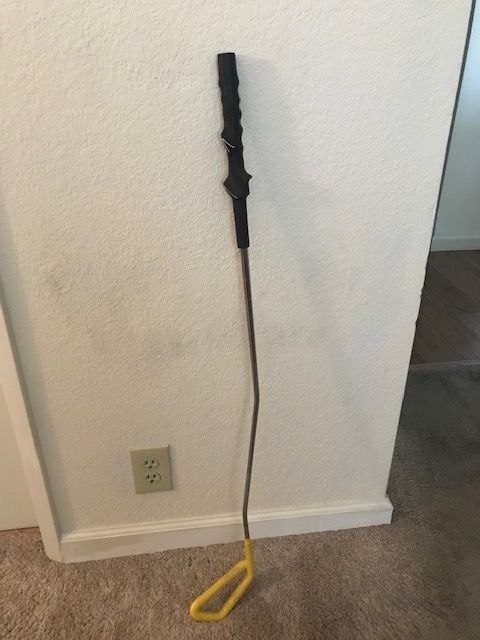
This is my trusty old "Assist" golf grip and swing trainer I have had for years (excuse the dirty wall...LOL).
Ultimately, finding the best golf grip for accuracy will require some experimentation and practice - what works well for one golfer may not work as effectively for another.
Importance of the Correct Golf Grip for Accuracy
If your grip is incorrect, it can cause problems with your wrist action and clubface rotation during the swing, leading to inconsistent shots and a lack of accuracy.
There are two common issues faced by golfers due to an incorrect grip: a weak or strong grip. A weak grip occurs when both hands are rotated too far counterclockwise on the club, making it difficult to square up the clubface at impact.
On the other hand, a strong grip occurs when both hands are rotated too far clockwise on the club shaft, leading to overactive hand movements during the swing that may result in hooks or pulls.
In order to achieve a neutral golf grip for maximum accuracy, it’s important to emphasize proper hand placement on the club. The right-hand position should complement that of your left-hand position on top of the golf club while maintaining uniform pressure throughout both hands.
In addition, ensuring proper alignment between your arms and shoulders will also help maintain accurate shot direction throughout your swing. Using a reliable golf grip trainer can also help establish proper hand positioning for maximum consistency in every shot you take!
Common Issues Faced by Golfers Due to Incorrect Grip
A lot of golfers, both beginners and experienced ones, struggle with incorrect grip. It's one of the most common issues faced by players on the course. The left hand grip on the golf club is crucial in determining how accurate and consistent your shots will be.
If you have a strong grip, you're more likely to hit shots that curve to the left (for right-handed players) or to the right (for left-handed players). I tried playing with a strong grip for awhile because it felt so powerful. Unfortunately, it ended up causing my swing to get out of whack too often so I switched back to neutral and that's where I'll stay.
On the other hand, if you have a weak grip, it's more likely that your shots will do the reverse of the above and lack power.
This is because your wrists tend to rotate too much during your swings. Another problem caused by an incorrect grip is poor contact with the ball. When you don't hold the club properly, it can be difficult to hit the sweet spot consistently.
As a result, your shots might feel weak and off-center. With time and practice, this can also lead to injury due to strain on your wrists and forearms.
If you don't hold onto the club tightly enough at impact or if you hold too tightly before impact then release too much after impact, there’s little chance of achieving consistent results from shot-to-shot.
Golf instructors or using training tools like golf grips trainers can help identify if your form is inconsistent so it can be corrected before bad habits are developed further down the line.
Different Types of Golf Grips
Hand Positioning
- Neutral golf grip
- Weak grip
- Strong grip
Styles of Golf Grips
- Vardon/Overlap
- Interlocking
- Ten Finger
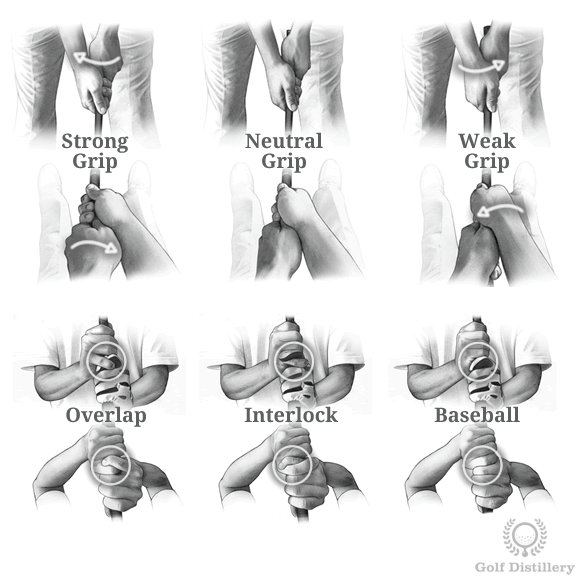
When it comes to golf, choosing the right grip is crucial, as it can influence the way you swing and ultimately affect your ball flight path.
Here are different types of golf grips that are commonly used by golfers:
First up is the “Neutral Grip.” This grip is also known as a basic or conventional grip and is typically recommended for beginners.
With this grip, you place your left hand grip on the golf club with your thumb pointing straight down towards the ground. Your right hand then fits over your left hand on the club with fingers overlapped.
Next, we have a "Weak Grip." With this grip, you rotate both of your hands slightly to the left so that they’re turned more towards the target. This will cause your left hand thumb position to be shifted slightly to the right of center on top of the club. This leads to an open clubface at impact which creates a slice spin for right-handed players.
Another type of golf grip is called “Strong Grip.” Strong means turning both hands towards right for Right handed players so that they’re rotated more away from target line leading to closed face angle at impact resulting in hook spin.
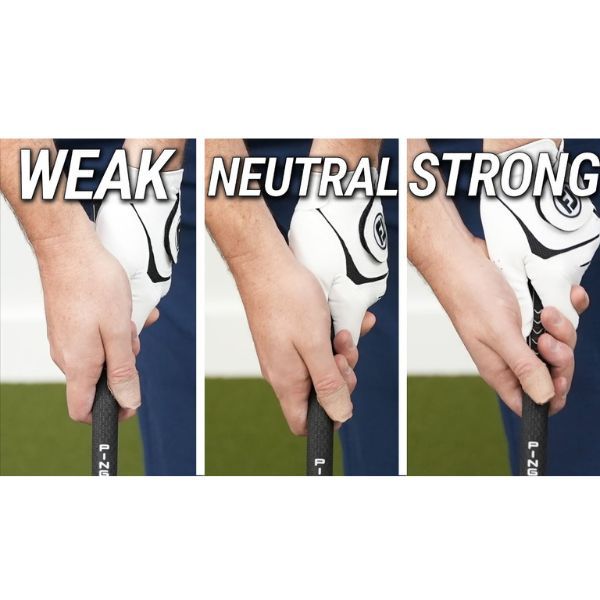
Importance of Hand Placement and Clubface Direction
A perfect golf swing requires proper hand placement on the club and an appropriate clubface direction to produce accurate shots. The way you hold the club and where you place your hands on it affects how the face of the club interacts with the ball.
Before hitting a shot, it is crucial to ensure that your hands are placed in a position that allows you to turn through impact while keeping control of the clubface. To make sure that you are holding the golf club correctly, focus on placing your left hand grip on the golf club first.
The correct position for most players is at an angle across the fingers rather than in the palm. Your left thumb should point towards your right shoulder and create a "V" shape between your thumb and index finger, which should point towards your right ear or shoulder.
Moreover, positioning your right hand grip correctly can help achieve an optimal ball flight path. While gripping with their right hand, many golfers tend to rotate their wrists too far to one side or use too much pressure with their fingers.
Both these tendencies make it harder for a golfer to square up their shots at impact, leading to inaccurate shots. This is where a neutral grip can be helpful in maintaining control over both sides of the ball's flight path.
In addition to proper hand placement on the golf club, having a square clubface at impact leads to consistent accuracy. To ensure this happens, focus on keeping your wrists from breaking down or flipping through impact as it changes how much loft you impart onto each shot.
Factors Influencing the Choice of Grip
One of the most important factors to consider when choosing a golf grip for accuracy is the individual golfer's swing style and physical attributes.
For example, a golfer with a fast swing speed might benefit from a stronger grip to help control the clubhead movement at impact. On the other hand, a golfer with a slower swing speed might find more success with a weaker grip to promote greater clubhead speed.
Another factor that can influence grip selection is the type of shot being played. Golfers looking for maximum power off the tee may use a different grip than those trying to hit precise approach shots.
A neutral golf grip is often recommended for players seeking accuracy since it minimizes any unwanted clubhead movements and allows for more consistent ball flight paths.
In addition to swing style and shot-type considerations, equipment can also play a role in determining which golf grip is best for accuracy. Some golfers may benefit from training aids to help them develop proper hand placement and alignment on the club.
Others may find that switching to a different size or material of golf club grip can improve their comfort level and control over their shots. Ultimately, selecting the best golf grip for accuracy requires careful consideration of all these factors as well as personal preference and experimentation through practice rounds.
By taking into account individualized needs, shot-type requirements, equipment options, and any necessary training aids or adjustments in hand placement, players can find the optimal grips that will help them hit more accurate shots on the course.
The Impact of Individual Movements on the Golf Swing
One of the most important things to understand about choosing the best golf grip for accuracy is that different grips will have a significant impact on individual movements in your golf swing.
For example, if you tend to take the club back too far inside, a strong grip may make this tendency even worse. Alternatively, if you struggle with coming over the top of your swing, a weak grip may exacerbate this issue.
The key to improving your accuracy through proper grip selection is understanding how each type of grip impacts your swing and then experimenting until you find the one that works best for you.
Specifically, where you place your left hand on the golf club can have a big impact on both your backswing and downswing. If you tend to slice or fade the ball, try moving your left hand more towards an interlocking or overlapping grip rather than a 10-fingered baseball style.
It's worth noting that finding the right golf grip for accuracy doesn't necessarily mean sacrificing power. While certain grips (such as those with a neutral or weak hold) may be better suited for accurate shots, there are also plenty of options that allow for strong swings while still maintaining control over ball flight path.
In the pursuit of golfing precision, it's common to mistakenly believe that it's a choice between accuracy and power. The reality, however, is much different. A correct and comfortable grip can lead to both a more controlled and a stronger swing.
The key is to find a grip that provides stability at the point of impact, enabling you to deliver a powerful strike without losing control of the ball's direction.
This balance is usually achieved through a grip that allows for the necessary wrist hinge in the backswing and follow through, without which power is likely to be compromised.
Selecting the right golf club grip can make all the difference when it comes to improving accuracy on the course. Understanding how individual movements in your swing are impacted by different grips is key so you can find one that works best for you – whether it's neutral or strong – while still maintaining control over ball flight path and maximizing power potential.
The Role of a Neutral Grip in Ensuring Accuracy
When it comes to ensuring accuracy, the role of a neutral golf grip cannot be overstated. A neutral grip is when your hands are directly opposite each other on the golf club, with the “V” formed by your thumb and index finger pointing towards your right shoulder.
This type of grip allows for maximum control and minimizes any unwanted clubhead movement during the golf swing. A neutral golf grip helps with consistency in ball flight path.
When you have consistent ball flight path with every shot it becomes easier to judge how far you need to hit for each shot and this leads to improved accuracy on course and lower scores.
Overall, while there are many types of grips used in golf such as overlap/ Vardon Grip or interlock/finger lock Grip or baseball/ten-finger Grip but The Neutral Golf Grip has maintained its popularity among professionals due to its ability to promote consistency and accuracy in ball flight path.
So if you’re looking for an easy way to improve your game and hit more accurate shots on the course then try experimenting with a neutral if you are not already using it.
Best Golf Grip for Accuracy - FAQs
What is the importance of grip in golf?
Grip is one of the most important aspects of playing golf. A good grip ensures that you have control over the club and can hit the ball accurately. It also helps you achieve a consistent swing and improves your shot-making abilities.
How does grip affect my golf swing?
The grip you use can have a significant impact on your golf swing. A proper grip helps you maintain your wrist angle and control the clubface, which results in a more consistent swing. The grip can also help you generate more power and control the trajectory of your shots.
What are the types of golf grips?
There are three main types of golf grips - the overlapping grip, the interlocking grip, and the ten-finger grip. The overlapping grip involves placing the little finger of your trailing hand over the index finger of your lead hand.
The interlocking grip involves interlocking the little finger of your trailing hand with the index finger of your lead hand. The ten-finger grip involves holding the club with all ten fingers, as if you were holding a baseball bat.
What is the best golf grip for accuracy?
The grip that is best for accuracy is the neutral grip. This involves placing your hands on the club in such a way that the V-shape between your thumb and index finger points towards your chin. It ensures that the clubface is square at impact, resulting in accurate shots.
How can I adjust my grip for better control?
You can adjust your grip for better control by changing the grip pressure. A lighter grip pressure can help you be more flexible and get more clubhead speed, whereas a stronger grip pressure can help you control the club and hit more accurate shots.
What is the impact of grip size on accuracy?
The grip size can have a significant impact on accuracy. If the grip is too big, you may have trouble controlling the clubface, and if it's too small, it can hinder your ability to generate power. Choosing the right grip size is important for accuracy.
How can I change my grip for wet weather conditions?
You can change your grip for wet weather conditions by using a glove to provide extra grip. You can also adjust your grip pressure to ensure that you have a more secure grip on the club, preventing it from slipping out of your hands.
Bonus Question - What is the ideal wrist position for an accurate shot?
What is the ideal wrist position for an accurate shot?
Here's a breakdown of the optimal wrist position throughout the swing for accuracy:
1. **Address:** At address, your wrists should be relatively neutral and relaxed, with the left wrist (for right-handed golfers) slightly flexed and the right wrist slightly extended.
2. **Backswing:** During the backswing, the left wrist should gradually hinge (or cock) upwards, creating an angle between the club shaft and the left forearm. By the top of the backswing, the left wrist should be flat or slightly bowed (bent towards the forearm), and the clubface should be parallel to the left forearm, which is a square position. This position helps to keep the clubface aimed at the target through impact, thus aiding accuracy.
3. **Downswing:** As you begin the downswing, maintain the wrist hinge from the top of the backswing. This stored energy will be released as you swing through the ball, contributing to both power and accuracy.
4. **Impact:** At impact, your left wrist should return to its original slightly flexed position while the right wrist is fully hinged or 'cocked'. This ensures a square clubface at impact, helping to direct the ball accurately towards the target.
5. **Follow-through:** After impact, both wrists should gradually un-hinge as you complete the swing.
Conclusion
Choosing the right golf grip for accuracy is crucial to improving your game. A neutral grip is the best option for most golfers, as it helps to ensure a consistent swing and proper ball flight.
However, it's important to note that individual factors such as hand size and strength may impact the choice of grip. One way to train yourself in finding the correct neutral grip is by using a golf grip trainer.
This tool can help you develop muscle memory and ensure that you are consistently gripping the club in the right position. Remember that a weak or strong grip may provide some benefits for other aspects of your game such as power or shaping shots, but they can also lead to inconsistent swings and erratic ball flights.
It's important to weigh these factors against their impact on accuracy before making a decision. Ultimately, focusing on proper hand placement and clubface direction will help you achieve greater accuracy regardless of what type of golf grip you use.
By paying attention to clubhead movement and ball flight path, you can make adjustments to fine-tune your swing over time. So get out there, practice with different grips, find what works best for you, and enjoy improving your game!
Thank you for visiting, and we hope to see you back soon!
